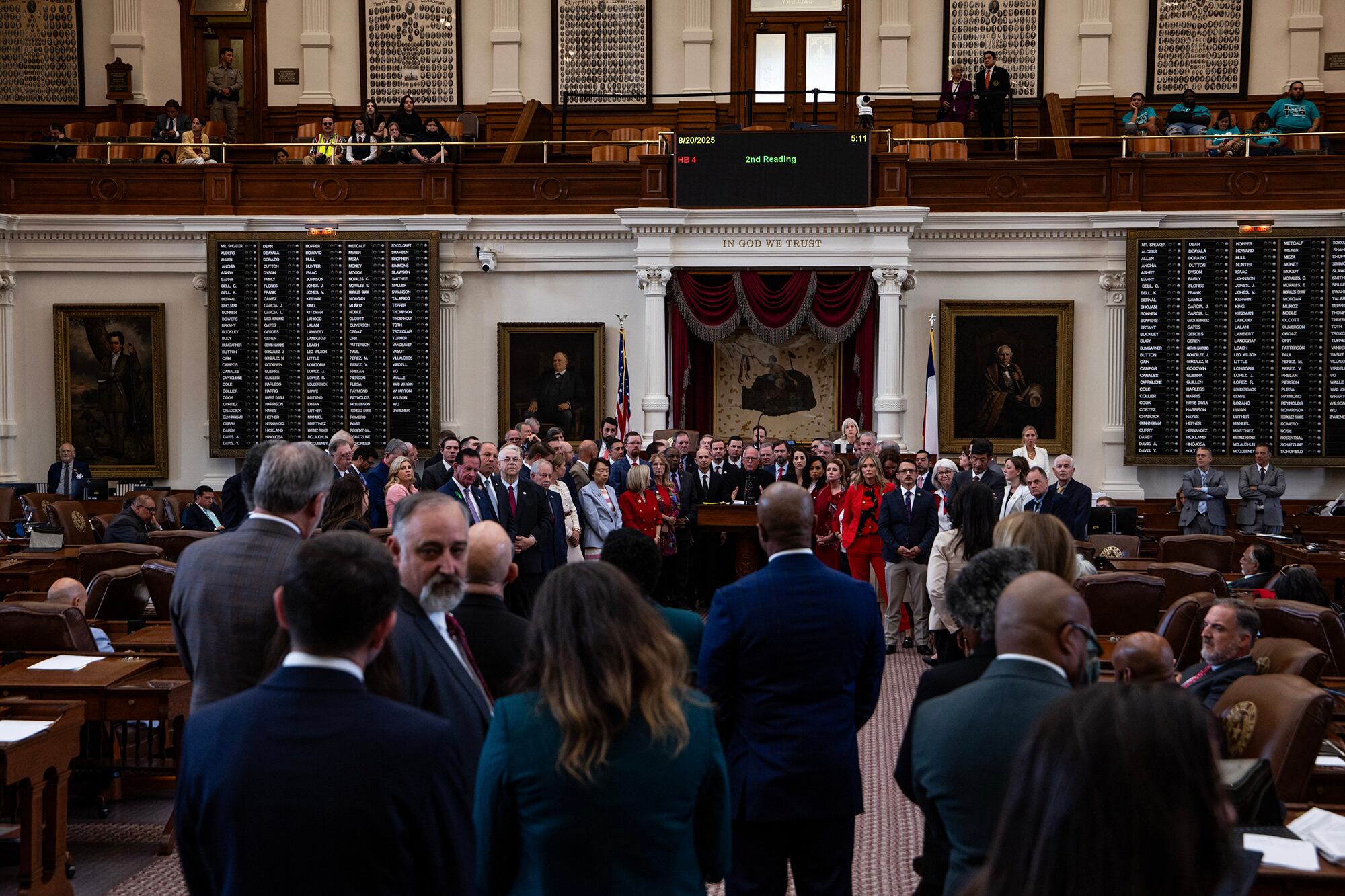Votebeat is a nonprofit news organization reporting on voting access and election administration across the U.S. Sign up for Votebeat Texas’ free newsletter here.
This story was first published by The Texas Tribune, a nonprofit, nonpartisan media organization that informs Texans — and engages with them — about public policy, politics, government and statewide issues.
The Republican-led Texas House on Wednesday approved a new congressional map crafted to hand five additional U.S. House seats to the GOP, over fierce opposition from Democrats, who cast the plan as a racially discriminatory attempt by President Donald Trump to stack the deck in next year’s midterm election.
The House adopted the map, 88 to 52, along party lines. A Senate panel advanced a similar map Sunday, and the full chamber was expected to send the new lines to Gov. Greg Abbott’s desk later this week.
Republican lawmakers are pursuing the unusual mid-decade redistricting plan, which has set off a national map-drawing war, amid pressure from Trump to protect the GOP’s slim majority in Congress. The effort comes just four years after the Legislature last overhauled the state’s congressional map following the 2020 census.
Democrats in the Texas House staged a two-week walkout over the plan in a bid to stall the map’s passage and rally a national response among blue states, where lawmakers could launch their own retaliatory redistricting efforts. The roughly two dozen Texas Democrats who returned to Austin on Monday said they were starting the next phase of their fight: putting the screws to their Republican colleagues and establishing a record that could be used in a legal challenge to the map.
Republicans have said the new districts were drawn purely to maximize their partisan advantage, arguing that the GOP’s margins of victory in 2024 supported new lines that entrenched their hold on power. They have also framed the effort as a response to Democratic gerrymandering elsewhere.
Rep. Todd Hunter, R-Corpus Christi, the map’s sponsor, emphasized in laying out House Bill 4 that Republicans were legally permitted to pursue redistricting in the middle of the decade and to maximize partisan gain.
“Redistricting can be done at any point in time,” he said. “The underlying goal of this plan is straightforward: improve Republican political performance.”
To create up to five Republican pickup opportunities, the map dismantles Democratic strongholds around Austin, Dallas, and Houston and makes Democratic-held seats in South Texas redder — all without seriously jeopardizing any of the 25 districts Republicans already control. The proposed map also would push a handful of Democratic members of Congress into seats already represented by other Democrats, setting up possible primary battles between long-serving members of the Texas delegation and younger newcomers.
The U.S. Supreme Court ruled in 2019 that states can draw electoral maps on partisan grounds. But under Section 2 of the Voting Rights Act, the map cannot diminish the voting power of people of color.
Democrats condemned the plan, arguing it widens Republicans’ partisan edge by unconstitutionally packing people of color — who are driving almost all of Texas’ population growth — into some districts while spreading them throughout others to reduce their ability to elect their preferred candidates.
“This bill represents one of the most blatant assaults on fair representation we have seen in Texas,” Rep. Ana Hernandez, D-Houston, said. “Diversity is our greatest strength. It is what makes our neighborhoods vibrant, our workforce dynamic and our communities resilient. HB 4 silences that diversity instead of celebrating it.”
Among the first points Democrats sought to make Wednesday was that the congressional map was the first piece of legislation the House was voting on, rather than flood-related bills responding to the devastating Hill Country floods. Several Democrats wore dark green in honor of the flood victims.
“Why was House Bill 1, the flood relief bill that is the House’s answer to the deadly July 4 flooding that killed over 135 people, not the first order of business of this special session for the Texas House?” Rep. Gina Hinojosa, D-Austin, asked on the floor.
Republicans reject all 12 Democratic amendments to congressional map
Republicans shot down 12 Democrat-proposed amendments Wednesday, including measures to block the map’s implementation until the release of the Jeffrey Epstein files, until the establishment of an independent redistricting commission, and until a federal court found that the plan would not suppress the vote of people of color.
The GOP-led House also rejected amendments to use the state’s current congressional map if the new lines are held up in court, and to only implement the new map within two years of the decennial census.
In proposing each amendment, Democrats sought to stretch out the debate and press their Republican colleagues on how race was considered in drawing the lines, in an effort to establish a record that they could bring to court in challenging the map on constitutional grounds.
Democrats tried to highlight the plan’s possible impact on people of color — who they argued will see their vote diluted under the new lines — and the fact that Republicans were redrawing the map in the middle of the decade, using five-year-old census data.
The map is “a clear violation of the Voting Rights Act and the Constitution,” said Rep.Chris Turner, D-Grand Prairie, after raising an amendment to sink the map. “This body has no business passing this bill. We need to kill it and get on with the real business of the people of this state.”
Republicans sink amendment seeking to tie map to release of Epstein files
An amendment from Democratic Rep. Gene Wu of Houston that sought to tie the implementation of the new congressional map to the release of the Jeffrey Epstein files was found to be not germane to the redistricting bill after another representative contested it, effectively killing the attempt to put Republicans in a political bind.
Wu said Wednesday morning he planned to introduce the amendment to force Republicans “to choose between their loyalty to Trump and their obligation to expose sexual predators.” But members ultimately did not debate the amendment or vote on it following the procedural challenge from Rep. Briscoe Cain, R-Deer Park, that was sustained by the House parliamentarian.
“The bill changes the composition of districts for the election of members to the United States House of Representatives,” Republican House Speaker Dustin Burrows said, reading the parliamentarian’s ruling. “The Wu amendment makes the effective date of the bill contingent on a matter that is not even remotely related to the congressional redistricting.”
House rejects amendment saying the map complies with the Voting Rights Act
The House voted down an amendment offered by Rep. Trey Martinez Fischer, D-San Antonio, to add a section to the bill saying that the map complies with Section 2 of the Voting Rights Act, which prohibits discrimination against voters on the basis of race.
The vote to reject the amendment was 87 to 51, along party lines.
Hunter, the map’s Republican sponsor, opposed the amendment, saying that the bill already complies with the Voting Rights Act.
“It’s unnecessary, and guess what? It’s incorporated in this bill,” he said.
The debate over the amendment grew heated at times, as Rep. Barbara Gervin-Hawkins, D-San Antonio, pressed Hunter on the lack of public input allowed on the map and its impact on Black and Latino voters.
“You own the walkout,” Hunter said to applause from Republicans, referring to Democrats’ two-week departure from the state to block action on the map. “But don’t come into this body and say we didn’t involve you. You left for 18 days, and that’s wrong.”
Martinez Fischer argued that if the map’s proponents were certain it complied with the Voting Rights Act, they should have no problem voting in favor of the amendment.
“It just says that we are going to follow Section 2 of the Voting Rights Act,” he said. “That’s it. There are no tricks. There are no hidden words. That’s all it does. It shouldn’t be controversial.”
Protesters gather in Capitol rotunda
As the Texas House began its debate on congressional redistricting, dozens of protesters gathered in the Capitol rotunda and their chants at times seeped into the chamber, albeit faintly.
The demonstrators rallied support for Rep. Nicole Collier, a Fort Worth Democrat who had been on the floor of the Texas House since Monday afternoon after she refused to sign a permission slip allowing members to leave the chamber only if they agreed to be shadowed by state law enforcement officers.
Collier was among the Democrats who participated in the two-week walkout.
“Let her out,” the protesters chanted, some holding a giant banner that read “Put Texans First.”






